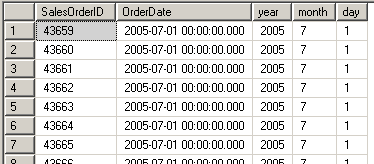SQL Server Table-Valued Function Example
A SQL Server table-valued function is a user-defined function which returns a table data type as output.
What makes SQL Server table-valued functions more useful in some situations than sql views or sql stored procedures is like every sql function, a t-sql table-valued function also accepts parameters.
Also TVF's (table valued functions) can be referenced in sql SELECT queries just like a SQL Server database table.
These two features plus creating complex t-sql programming logic in user defined functions make a table-valued function powerful than the SQL view and SQL stored procedure objects.
The most well-known use of SQL Table-Valued Function is sql string split function.
Perhaps sql developers can think of the above example as part of this t-sql tutorial.
The following t-sql table-valued function example can be executed on Microsoft SQL Server 2008 R2 sample database AdventureWorks.
create function udf_ParseDate (
@date as datetime
) returns @dateinfo table (
id int identity(1,1),
[date] datetime,
[year] int,
[month] smallint,
[day] smallint
)
as
begin
insert into @dateinfo
select @date, YEAR(@date), MONTH(@date), DAY(@date)
return;
end
In fact, the above date parser function only returns a single row.
You might prefer to extract Year, Month, and Day date parts within SELECT statements without using a table-valued function.
But please think of udf_ParseDate table-valued function as a starting point in this t-sql tutorial.
select
o.SalesOrderID, o.OrderDate,
d.[year], d.[month], d.[day]
from Sales.SalesOrderHeader o
cross apply dbo.udf_ParseDate(o.OrderDate) d
The output of the above sql TVF is as follows.
In this t-sql tutorial, I want to give a derived date table example too.
The following t-sql table valued function can be used by t-sql programmers in order to create a table where the start and end date ranges are given as a parameter.
create function udf_CreateDateTable (
@mindate as date,
@maxdate as date
) returns @datetable table (
id int identity(1,1),
[date] date
)
as
begin
declare @i int = 0, @j int = DATEDIFF(dd, @mindate, @maxdate)
while @i <= @j
begin
insert into @datetable
select dateadd(d, @i, @mindate)
set @i = @i + 1
end
return;
end
T-SQL programmers can use the above user defined table-valued function to find the missing date gaps in SalesOrderHeader table according to the OrderDate column.
Again for this table-valued function example (TVF), I want to use AdventureWorks table.
with cte as (
select
[MIN] = MIN(o.OrderDate),
[MAX] = MAX(o.OrderDate)
from Sales.SalesOrderHeader o
)
select d.id, d.date
from cte
cross apply dbo.udf_CreateDateTable(cte.MIN, cte.MAX) d
where not exists (
select * from Sales.SalesOrderHeader where OrderDate = d.date
)
The following t-sql query which is using TVF - Table Valued Function udf_CreateDateTable will display the dates where no sales order has been created.
Here is the 3 days where no order was created in our AdventureWorks sample database table SalesOrderHeader.


